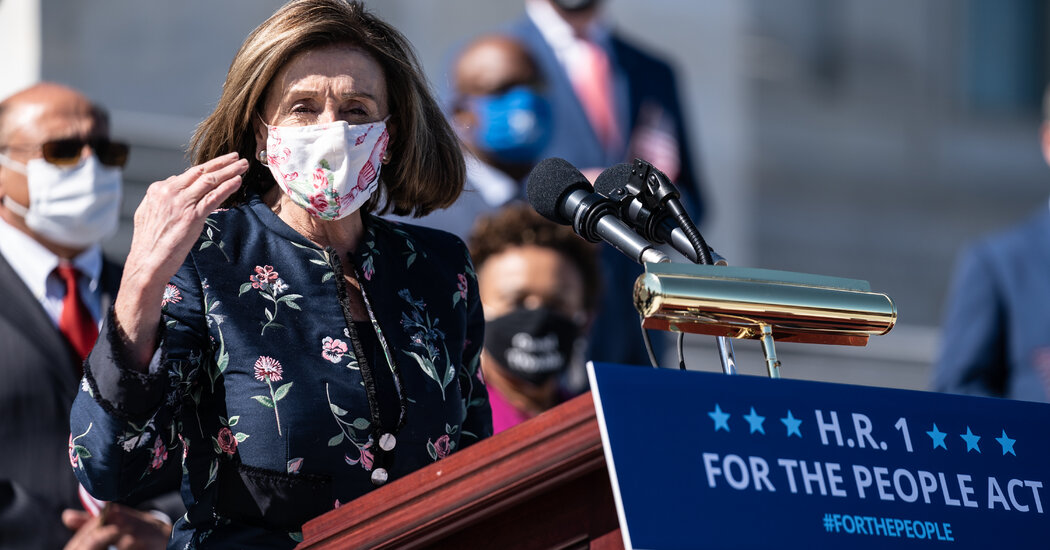
Senate Voting Rights Bill Expected to Run Into Filibuster


The Senate will consider a Democratic bill on Tuesday that, if enacted, would be the most expansive federal election overhaul in generations. Republicans are expected to use the filibuster to block debate.
Democratic leaders plan to call a test vote to try to advance the bill, known as the For the People Act, though they are all but certain to fail. As Republican-led states rush to enact restrictive voting laws, Democrats have presented the legislation as the party’s best chance to undo them, expand ballot access and limit the impact of special interests on the political process.
“We can argue what should be done to protect voting rights and safeguard our democracy, but don’t you think we should be able to debate the issue?” Senator Chuck Schumer, Democrat of New York and the majority leader, said on Monday in a last-ditch appeal to Republicans to let the bill proceed.
But even if all 50 Senate Democrats vote to advance the bill, it is expected to fall well short of the 60 votes needed to begin debate.
That would leave Mr. Schumer with only one option to try to pass the legislation: blowing up the legislative filibuster. Progressives, who have clamored to do so since Democrats won a narrow Senate majority in January, argued that the vote would help make their case. But a handful of moderates, led by Senator Joe Manchin III of West Virginia, say they will never go along.
With the path forward so murky, top Democrats are framing Tuesday’s vote as a moral victory. The White House endorsed a compromise framework proposed last week by Mr. Manchin under the assumption that it would be enough to persuade him to vote yes.
“What we are measuring, I think, is: Is the Democratic Party united? We weren’t as of a couple of weeks ago,” Jen Psaki, the White House press secretary, said before acknowledging the vote would fail.
She suggested the outcome might “change the conversation on the Hill” around the filibuster, but offered no clear next steps.
Mr. Manchin opposed key planks in the original For the People Act as too intrusive into the rights of states to regulate their elections. His proposal would eliminate a public campaign financing program and a provision neutering state voter identification laws.
But it would preserve other measures, like tough new ethics rules and an end to partisan gerrymandering of congressional districts. It would also expand early voting, make Election Day a federal holiday and make it easier to vote by mail.
On Monday, former President Barack Obama tepidly endorsed Mr. Manchin’s version as the best chance to pass a new federal voting law.
“The bill that’s going to be debated, including Senator Manchin’s changes, would address, as Eric mentioned, many of the concerns and issues that I was just discussing,” Mr. Obama said during a call with former Attorney General Eric H. Holder Jr. and supporters. “I’ll be honest, the bill doesn’t have everything I’d like to see in a voting rights bill. It doesn’t address every problem.”
Republicans are united in their opposition to both Democrats’ original bill and Mr. Manchin’s changes, describing them as poorly drafted and overly prescriptive.
“The real driving force behind S. 1 is the desire to rig the rules of American elections permanently, permanently in Democrats’ favor,” said Senator Mitch McConnell, Republican of Kentucky and the majority leader, referring to the measure by its bill number. “That’s why the Senate will give this disastrous proposal no quarter.”
News Analysis

The Democrats’ expansive voting rights and ethics bill did not start as a battle for the future of democracy, as they frame it, or as the partisan power grab that Republicans call it. The initial driver was the ethical norm-breaking of President Donald J. Trump and his White House.
When House Democrats sat down to write the bill in 2019, passage was the farthest thing from their minds. Democrats running for the House in Republican-leaning districts had campaigned on a poll-tested message of ending corruption in Mr. Trump’s Washington, rooting out money from politics, and ending partisan gerrymandering.
Their newly elected speaker, Nancy Pelosi, wanted to enshrine those campaign pledges as the first bill of the new Democratic House, House Resolution 1 — a transformative measure, but with Republicans controlling the Senate and Mr. Trump in office, one that had no chance of becoming law.
By this year, circumstances had changed dramatically — after the effort by Mr. Trump and his supporters to overturn the results of the 2020 election and amid a rush by Republicans to enact a wave of state-level legislation impeding ballot access — but the bill had not.
What started out as a largely political document suddenly was being portrayed by Democrats as an imperative to preserve voting rights and a crucial test of democracy itself. And although Republicans in Congress made it clear they would oppose any bid to expand ballot access, Democratic leaders vowed to use their narrow majorities in the House and the Senate to try to push it through.
The failure of that strategy will become clear on Tuesday. With Republicans making good on their promise to block it, a first procedural vote in the Senate will leave the legislation far short of the 60 votes it needs to advance, dooming the bill and leaving Democrats with an issue to campaign on — but not the big legislative victory progressives had sought.
The blockade will preserve the status quo post-Trump, freezing action indefinitely in Washington as Republicans at the state level proceed largely unencumbered with new laws curtailing early and mail-in voting, while installing partisans to oversee and certify the next election.
Video

A Senate committee on Tuesday discussed legislation that would establish Washington, D.C., as the nation’s 51st state, after the House passed the measure along party lines earlier this year.
The legislation would create a state called Washington, Douglass Commonwealth — in honor of Frederick Douglass, the Black emancipation and civil rights leader — represented by a single voting representative in the House and two senators for its more than 700,000 residents, many of whom are people of color. Some government property — including the National Mall, the White House and Capitol Hill — would be left under federal control.
While the measure is unlikely to clear the 60-vote filibuster threshold given widespread Republican opposition and skepticism among some moderate Democrats, Senator Tom Carper, Democrat of Delaware, pushed for the Homeland Security Committee to hold the hearing, just the second on the topic in the chamber’s history. He oversaw the first such hearing in 2014, when he served as chairman of the committee.
“Our nation’s capital is home to more than just monuments and museums; it is home to American families who go to work, start businesses, pay their taxes and contribute to America’s economic prowess,” Mr. Carper said as the hearing began. “As every Congress passes, we are failing these fellow Americans and coming well short of our founders’ rallying cry of ‘no taxation without representation.’”
Momentum for statehood has intensified since that inaugural Senate hearing, as advocates and allies of the movement have argued that making the nation’s capital a state would end the disenfranchisement of district residents. The pandemic underscored the disparate treatment of the district, which received less federal emergency relief through the expansive coronavirus aid bill than expected because it is not a state.
President Biden has also said he supports statehood for the district.
Mayor Muriel E. Bowser, Eleanor Holmes Norton, the district’s lone nonvoting representative in the House, and Senator Joe Lieberman, an independent who pushed for the legislation during his time in the Senate, appeared before the committee to speak on the issue.
One Democrat on the committee, Senator Kyrsten Sinema of Arizona, has not yet said whether she supports the legislation, although 45 of the senators who caucus with Democrats have signed on. Republicans have argued that the bill is unconstitutional, an argument that the White House has privately sought to counter with suggested changes.

The White House on Tuesday publicly acknowledged that President Biden does not expect to meet his goal of having 70 percent of adults at least partially vaccinated by July 4 and will reach that milestone only for those aged 27 and older.
It would be the first time that Mr. Biden has failed to meet a vaccination goal he has set. If the rate of adult vaccinations continues on the current seven-day average, the country will come in just shy of Mr. Biden’s target, with about 67 percent of adults partly vaccinated by July 4, according to a New York Times analysis.
White House officials have argued that falling short by a few percentage points is not significant, given all the progress the nation has made against Covid-19. “We have built an unparalleled, first-o-its-kind, nationwide vaccination program,” Jeffrey D. Zients, the White House pandemic response coordinator, said at a news briefing. “This is a remarkable achievement.”
In announcing the goal on May 4, Mr. Biden made a personal plea to the unvaccinated, saying getting a shot was a “life and death” choice. According to the latest figures from the Centers for Disease Control and Prevention, 150 million Americans have been fully vaccinated and 177 million have received at least one dose.
Young adults aged 18 to 26 have so far proven particularly hard to persuade. “The reality is many younger Americans that felt like Covid-19 is not something that impacts them, and they’ve been less eager to get the shot,” Mr. Zients said.
He said it would take “a few extra weeks” to reach more of that group to achieve the goal of 70 percent of adults at least partially vaccinated.
Mr. Zients and Dr. Anthony S. Fauci, the nation’s top infectious disease expert, both stressed that the administration’s efforts would continue long after that benchmark is reached. Seventy percent “is not the goal line, nor is it the end game,” Dr. Fauci said. “The end game is to go well beyond that, beyond July 4 into the summer and beyond, with the ultimate goal of crushing the outbreak completely in the United States.”
But health experts warn that the falloff in the vaccination rate could mean renewed coronavirus outbreaks this winter when cold weather drives people indoors, with high daily death rates in areas where comparatively few people have protected themselves with shots.
“I give credit to the Biden administration for putting in place a mass vaccination program for adults that did not exist,” said Dr. Paul Offit, the director of the Vaccine Education Center at Children’s Hospital of Philadelphia. “But now we’ve hit a wall.”
In recent weeks, new infections, hospitalizations and deaths related to the virus have declined sharply nationwide. As of Monday, the seven-day average of new virus cases across the United States was 11,243 cases a day, a nearly 30 percent decrease over the last two weeks, according to a New York Times database.
But Dr. Fauci also warned of the rising prevalence of the Delta variant, first identified in India, which is more contagious than previous versions of the virus and may cause more severe disease. The variant now accounts for an estimated 20 percent of new infections, he said.
The vaccines authorized in the United States are effective against the Delta variant, and he said the increase lent urgency to the campaign to vaccinate as many Americans as soon as possible.
Unless tens of millions more Americans get vaccinated in the next few months, Dr. Offit said, “I think, come winter, we are going to again see a surge. And that surge is going to occur exactly where you would expect it to occur — in areas that are unvaccinated or under-vaccinated.”
Dr. Fauci said that “there is a danger, a real danger, that if there is a persistence of a recalcitrance to getting vaccinated that you could see localized surges” or regional spikes.
But he added: “I don’t think even under those circumstances that you’re going to see things like 1,000 deaths a day.” At the height of the post-holiday surge in January, the known daily death toll in the United States exceeded 4,000.
Lazaro Gamio contributed reporting.

Priorities USA, one of the biggest Democratic super PACs, announced on Tuesday that it will pump $20 million into voting rights initiatives ahead of the 2022 election cycle, aiming to combat Republican-led election laws with digital ads and organizing as well as in the courts.
The digital effort will include a series of extensive voter information campaigns, going beyond a more traditional approach that would consist solely of persuasion ads. The group’s overall goal is to help people navigate a new balloting landscape created by the many new restrictions passed by Republicans in at least 16 states. The campaigns will also provide voting tools like text message reminders to register to vote or request an absentee ballot.
“The purpose of this program is to really center the voters who we know are particularly targeted by the Republicans’ suppression efforts,” said Danielle Butterfield, the executive director of Priorities USA. “Those are voters of color, Black and Latino voters specifically, and we plan to center them both in our creative and our targeting to make sure that they are aware of how empowering voting is.”
The other significant investment will be on the legal front, where the group has served as one of the leading litigators in voting lawsuits across the country. Priorities USA joined lawsuits in 10 states during the 2020 election and its aftermath, squaring off against legal attempts by Donald J. Trump’s campaign to overturn the election results and pushing back on new voting laws. Though Priorities has not sued any state this year in response to new voting restrictions, group officials said that more legal efforts would be coming soon.

President Biden is set to meet with the Afghan president, Ashraf Ghani, on Friday to discuss humanitarian assistance and security in Afghanistan, which has faced an insurgent offensive by the Taliban since the United States began to withdraw its military forces from the region.
There is increasing concern among members of Congress and former military officials that without U.S. support Afghan troops will be overrun by the Taliban.
On Sunday, the Taliban advanced into Kunduz city, the capital of the province of the same name, as well as Maimana, the capital of Faryab Province, where they clashed with security forces. The Taliban have taken control of more than 50 districts in Afghanistan through local mediation, military offenses and government retreats since May 1, when U.S. forces officially began their withdrawal, according to data collected by The New York Times.
“I expect their topic, their focus of their conversation will be to continue to discuss how we can work together to ensure that Afghanistan never again becomes a safe haven for terrorist groups who pose a threat to the U.S. homeland,” Jen Psaki, the White House press secretary, said on Monday.
The administration is facing growing calls to assist Afghans who aided the American military and expected to find sanctuary in the United States, only to encounter bureaucratic delays in the Special Immigrant Visas program for people who have helped Americans overseas.
A bipartisan coalition in Congress introduced legislation on Thursday that would expedite these visas for Afghans and increase the number available to 19,000 from 11,000. The group has also joined immigration advocates in lobbying the Biden administration to arrange for the mass evacuation of Afghan applicants while visas are processed. The Biden administration has resisted such a move.
In a recent interview with CNN, Secretary of State Antony J. Blinken called evacuation “the wrong word,” and said the focus should instead be on improving the functioning of the visa program.

The White House is considering extending by one month a federal moratorium on evictions scheduled to expire on June 30, in a bid to buy more time to distribute emergency housing aid, according to three people with knowledge of the situation.
The freeze, instituted by the Centers for Disease Control and Prevention last fall to stave off an anticipated wave of evictions spurred by the economic downturn during the pandemic, has significantly limited the economic damage to low-income and working-class renters, according to local officials and tenants’ rights groups.
But the moratorium was never considered more than a stopgap, and landlords have prevailed in several recent federal court cases challenging the legal justification for the C.D.C.’s order — the public health risk posed by the dislocation of tenants during the pandemic.
Local officials have been bracing for a rise in evictions as the federal moratorium and similar state and city orders expire this summer. In some cases, that scramble to assist tenants has dovetailed with the broader goal of improving affordability that is now a core part of the Democratic Party’s agenda.
On Monday, Gov. Gavin Newsom of California announced that the state had set aside $5.2 billion from federal aid packages to pay off the back rent of any tenant who fell behind during the pandemic, an extraordinary move intended to wipe the slate clean for millions of renters in a state dealing with acute homelessness and a housing affordability crisis.
President Biden’s team has been seeking ways to speed up the sluggish distribution of $21.5 billion in emergency rental assistance allocated in the American Recovery Act this spring.
The group met throughout the weekend to discuss potential moves, including the idea of pushing back the deadline until the end of July, which has been under consideration for weeks, the officials said.
But they have yet to sign off on an extension, in part, over concerns in the White House Counsel’s Office that leaving the freeze in place, even for a month, could expose the order to a ruling that could affect executive actions during future crises, one of the officials said.
Administration lawyers are particularly concerned that the Supreme Court will strike down a stay in a lower court decision that ruled the moratorium unconstitutional.
Mr. Biden’s team is pushing ahead with several other actions, including issuing new guidance on using pandemic relief funds that could speed up distribution of payments by states, and increasing coordination with mayors, bar associations and legal services organizations.
But tenants’ rights groups say that simply stopping the clock is the most important action.
“Extending the moratorium is the right thing to do — morally, fiscally, politically, and as a continued public health measure,” said Diane Yentel, the president of the National Low Income Housing Coalition, who has pressed the White House for an extension. “Allowing evictions to proceed when there are tens of billions in resources to prevent them would be wasteful and cruel.”

Lumber prices soared over the past year, frustrating would-be pandemic do-it-yourselfers, jacking up the costs of new homes and serving as a compelling talking point in the debate over whether government stimulus efforts risked the return of 1970s-style inflation.
The housing-and-renovation boom drove insatiable demand for lumber, even as the pandemic idled mills that had already been slowed by an anemic construction sector since the 2008 financial crisis. Lumber futures surged to new heights, peaking at more than $1,600 per thousand board feet in early May, The New York Times’s Matt Phillips reports.
But since then, the prices of those same plywood sheets and pressure-treated planks have tumbled, as mills restarted or ramped up production and some customers put off their purchases until prices came down. Lumber prices in the futures market, for example, are down more than 45 percent from their peak, slipping below $1,000 for the first time in months. That’s still high — from 2009 to 2019, prices averaged less than $400 per thousand board feet — but the sell-off has been gaining momentum over the last few weeks.
It’s a dance of supply and demand that has reassured many experts and the Federal Reserve in their belief that painful price jumps for a range of products like airline tickets and used cars will abate as the economy gets back to normal.
Why have prices fallen so fast? It’s partly because they set off a surge of production at the country’s roughly 3,000 sawmills.
Mostly concentrated in the rich belt of Southern yellow pine that stretches from the woods of East Texas to the Carolinas, mills buzzed back to life in a rush to sell wood for prices few would have imagined possible a couple of years ago.
“Nobody’s not running capacity right now,” said Joe Hankins, sales manager at Hankins Lumber, a sawmill and timber company in the north-central Mississippi town of Grenada.
The professional homebuilding industry, the largest source of demand for lumber, is also decelerating from a breakneck pace, with some builders citing high prices for wood as a reason to hold off on construction.
Those decisions by consumers and companies are a major reason some analysts think the recent rise in inflation is the result of temporary mismatches in supply and demand, rather than a harbinger of runaway price increases stoked by all the money pouring into the economy.
The lumber market’s behavior is a sign of consumer sanity, said Kristina Hooper, chief global market strategist at the investment management firm Invesco.
“We don’t have that kind of buying frenzy that creates sustained inflation,” she said.

WASHINGTON — A federal judge on Monday partly dismissed claims filed by Black Lives Matter, the American Civil Liberties Union and others accusing the Trump administration of abusing its power to violently disperse a protest outside the White House last year.
The lawsuits alleged that the government violated protesters’ civil rights and conspired to clear Lafayette Square so President Donald J. Trump could walk to a church near the White House, where he held a Bible outside in a photo op.
But in the 51-page ruling, U.S. District Judge Dabney L. Friedrich, a Trump appointee, said the claims of a federal conspiracy were “simply too speculative” to allow those parts of the suits to proceed. She also ruled that the federal officials at the time who were named as defendants, such as Attorney General William P. Barr and Gregory T. Monahan, the acting chief of the U.S. Park Police, were entitled to qualified immunity and could not be sued for damages over the episode.
Judge Friedrich did, however, allow lawsuits challenging continued restrictions of protester access to Lafayette Square and against local police agencies in Washington and Arlington County, Va., to proceed.
Scott Michelman, the legal director of the District of Columbia chapter of the American Civil Liberties Union, said in a statement that the decision to dismiss was a “stunning rejection of our constitutional values and protesters’ First Amendment rights.” He added that the decision placed federal officials above the law.
“Today’s ruling essentially gives the federal government a green light to use violence, including lethal force against demonstrators, as long as federal officials claim to be protecting national security,” Mr. Michelman said.
Protesters had gathered in Lafayette Square last June to protest the police killing of George Floyd when police officers and the National Guard flooded into the park to disperse the crowd.
The ensuing violence became one of the defining moments of the Trump presidency. Mounted police and riot officers used flash-bang grenades, tear gas, batons and clubs to forcibly move the crowd away from the park and the historic St. John’s Episcopal Church, which had been damaged in a fire the night before.
Minutes later, Mr. Trump appeared at the church — flanked by aides and Secret Service agents. The president posed with a Bible, made no formal remarks and then departed for the White House.
Video

Jerome H. Powell, the Federal Reserve chair, will offer an optimistic take on the United States economy but little hint at what comes next for monetary policy in prepared remarks set for delivery before House lawmakers on Tuesday afternoon.
Economic growth this year “appears to be on track to post its fastest rate of increase in decades,” Mr. Powell is scheduled to say, while noting that the strength marks recovery from very low levels.
His testimony comes on the heels of the Fed’s meeting last week, in which officials held interest rates steady but suggested they were expected to rise modestly from near-zero levels by the end of 2023.
Mr. Powell will tell lawmakers that “conditions in the labor market have continued to improve, although the pace has been uneven,” and that “job gains should pick up in coming months as vaccinations rise, easing some of the pandemic-related factors currently weighing them down.”
Although inflation has picked up sharply — fueling debate in Washington and on Wall Street over whether the government has overdone its pandemic response — the Fed chair will say that the recent pace of price gains is unlikely to last. But he will give little guidance about what the combination of a strengthening economy and stabilizing prices will mean for central bank policy.
“The Fed’s policy actions are guided by our dual mandate to promote maximum employment and stable prices for the American people, along with our responsibilities to promote the stability of the financial system,” Mr. Powell will say, without getting into much further detail.
The Fed has held its policy interest rate close to rock bottom since March 2020 and is buying $120 billion in government-backed bonds each month, policies that are meant to keep many kinds of borrowing cheap, pushing money through the economy and bolstering demand.
Mr. Powell’s testimony comes after the Fed’s June policy meeting fueled days of selling in the stock market. Policymakers released an optimistic set of economic projections, and more than half penciled in rate increases in 2023 — earlier than they had previously expected. Mr. Powell downplayed the significance of those projections, but did offer a sunny economic outlook, and signaled that the Fed was beginning to talk about when and how to slow down its asset purchases.
The Fed chair is likely to face questions about the central bank’s vast coronavirus rescue package, which saw it backstopping corporate bond markets, municipal debt and even midsize businesses amid market turmoil last year. He is scheduled to speak before the Select Subcommittee on the Coronavirus Crisis.


















